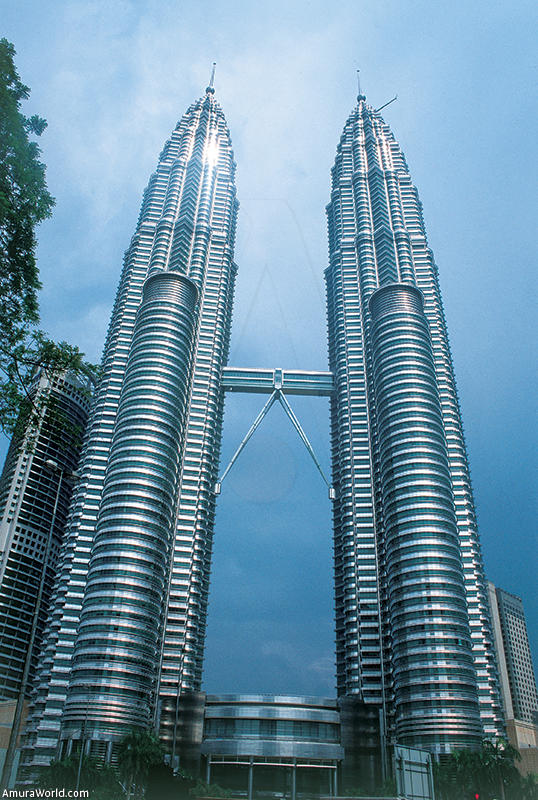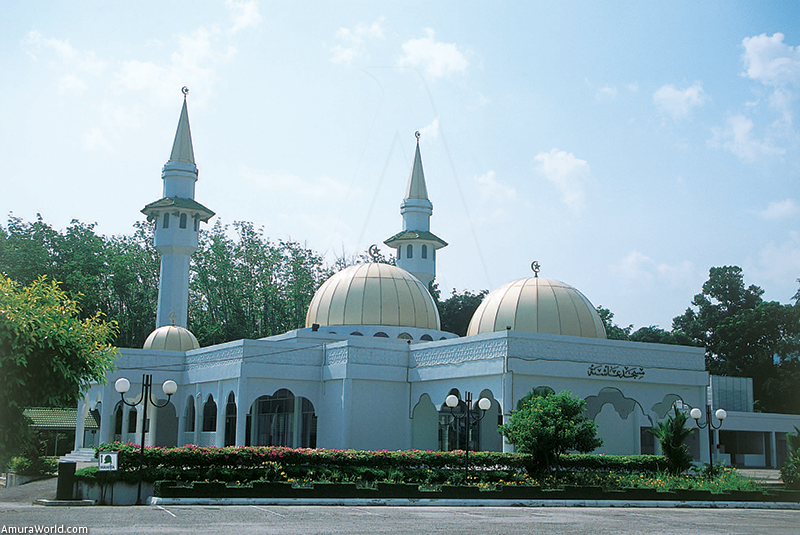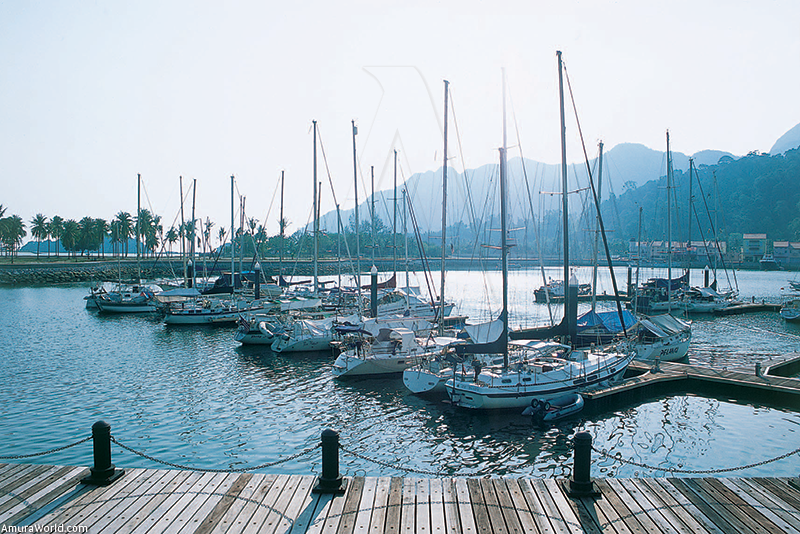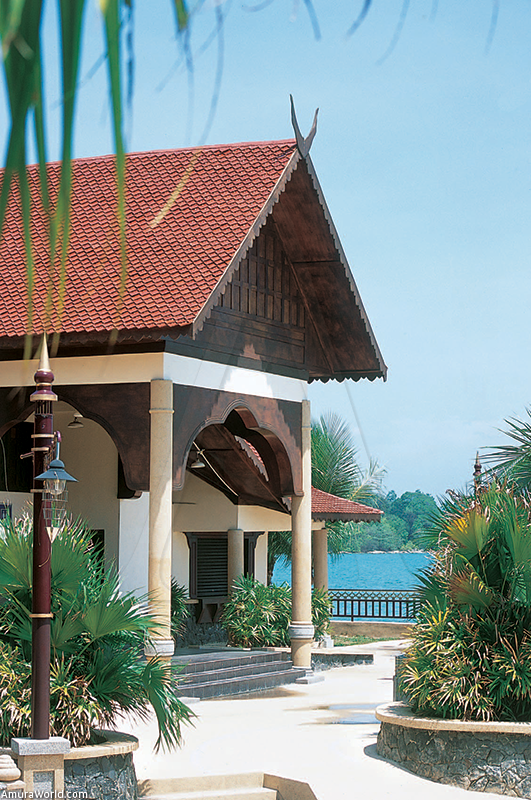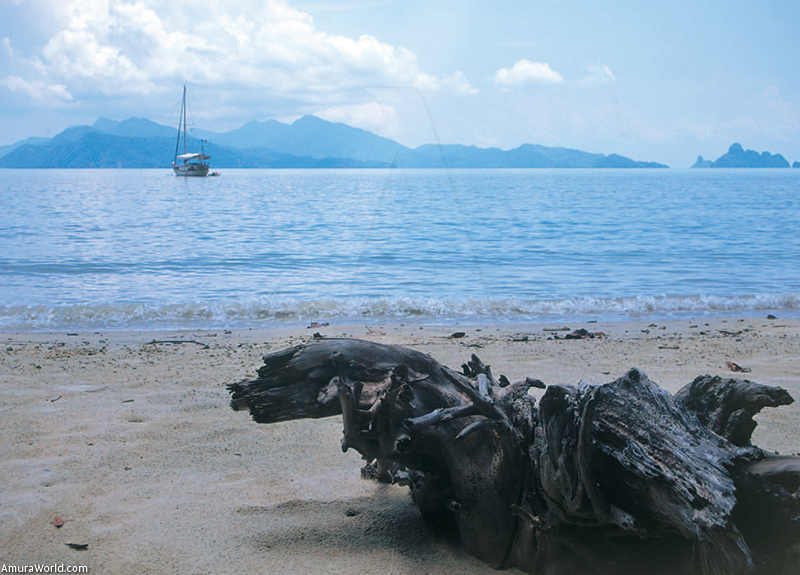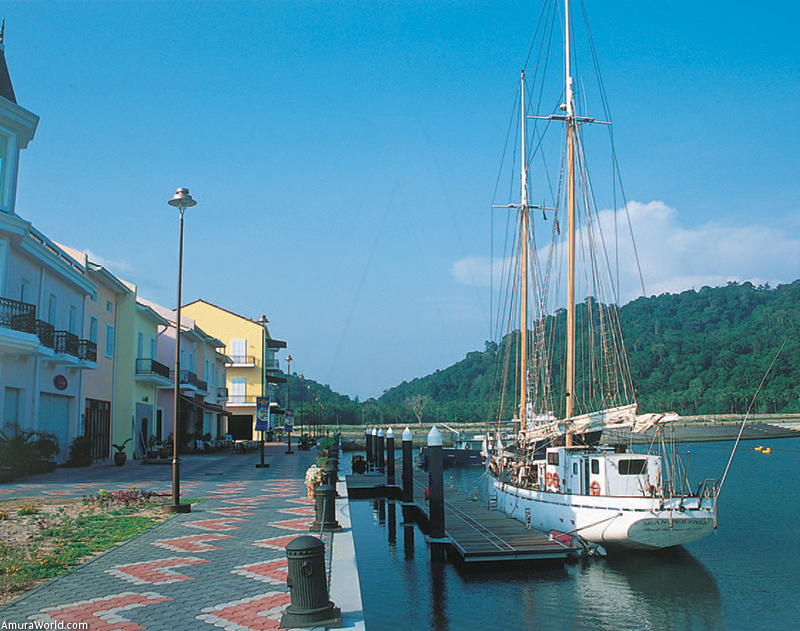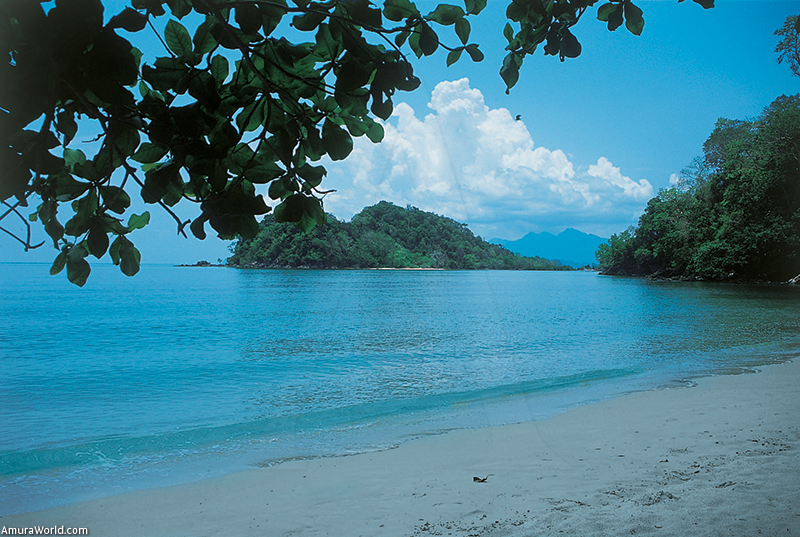An Exclusive Island in Malaysia
Our blue planet is a word of surprises and we discover some places just because they have become trendy. Unknown yesterday, Langkawi island has risen to fame because some of the world’s most exclusive, elegant hotels are located there. Celebrities and members of the jet set settle in to enjoy life here, far from the interest sparked by their popularity. And that choice implies taking pleasure in a different kind of paradise, that is to say, from the more popular destinations, like the Caribbean.
Situated north of the west coast of Malaysia, on the border of Thailand, you can reach Langkawi from Bangkok or Kuala Lumpur. In order to get to our starting point we arrived at Kuala Lumpur, the magnificent capital of Malaysia, a beautiful city of skyscrapers rising above the jungle. The highways crisscross the metropolis in an intelligent manner, linking one neighborhood with another, from the shopping malls in the green hills to the business center where the Petronas Towers reign. Until recently, these two impressive towers, joined by a shiny grey bridge on the 42nd floor, were the highest in the world (451.9 meters /1,482 feet). They compete in the sky of KL with the Menara communications tower (421 meters /1,381 feet), and dominate the narrow streets of China Town with its bazaar, teahouses, market, Sze Yah, a Taoist temple ; and of Little India, with its Sri Mahamariamman, a Hindu temple, an indication of good understanding among the different cultures.
The Colonial District is a facet of its romantic past, when elegant English women strolled in the shadow of the enormous banyan trees, on the avenue that borders Merdeka Square, the former heart of the city, which was then called “The Padang,” and where the men played cricket. All the buildings in this neighborhood are Victorian style, a symbol of English supremacy. Some examples are the Royal Selangor Club (where members of the colony’s high society gathered), the train station (built in 1911, with its domes, minaret-style towers and Moorish arches), the Sultan Abdul Samad Building (with its mixture of Islamic and Victorian architecture), the Saint Mary Cathedral (1894), opposite the Masjid Jamek Friday mosque, built in 1907, where the Klang and Gombak rivers meet amidst palms and that is lit up when the sun is reflected on its domes and minarets. The Museum of Natural History and the KL Memorial Library are other beautiful examples of England’s presence.
Masjid Negara, situated in a beautiful, five hectare (12.35 acre) garden, is considered to be the largest mosque in Southeast Asia, with its main dome dominating the building’s 48 domes, and its 73 meter (239.50 feet) tall minaret. From their hilltop, Carcosa—Sir Frank Swettenham’s old mansion—and the Seri Negara Guest House overlook Lake Garden and the memories of a city that is racing toward the future. Its white Victorian verandas are the place to enjoy the past within a beautiful tropical garden, inviting visitors to admire the view of the skyscrapers that dominate the hills of the new city. Today, Carcosa Seri Negara is an exclusive hotel, an experience of yesteryear designed for resting from the hustle and bustle of today.
In KL the past is always present though there is no time to lament it as the city rushes toward a promising future. Its airport is a work of art of modern technology, but to find yourself, once again, in the enchantment of the past we suggest visiting Melaka and Cameron Highlands, a short distance away.
When it was a colony, the English took respite from the heat in the “Hill Stations”, and Cameron Highland (between 1300 and 1829 meters high /4265 and 6000 feet), is three hours from KL. The temperature varies between 10 and 21 °C (50 and 70 °F), it rains frequently, the dense jungle blankets the hills where the rivers flow dotting the surroundings with waterfalls and lakes. Tea plantations adorn the countryside, golf courses vanish into the forest and the “English Cottage”-style homes recall far-away England with its beautiful gardens and orchids. It is the jet set’s favorite spot for getting away from the heat, playing golf, enjoying the restaurants and taking pleasure in the fireplace while the afternoon rains cool off the air and the fog filters through the trees. Cameron Highland is an enchanted, permanently green garden that floats among the clouds.
It was an important harbor that was occupied by the Portuguese, Dutch and English, and it dominated Southeast Asian trade. It was the port of call for most ships returning to Europe. Witnesses to its glorious past are Stadthuys (the Dutch government office and residence, 1641), the Dutch church (1753), the St. Paul church (built on a hill by the Portuguese in 1521), the St. James port (a faithful witness of the wall), the streets of China Town, a center of commerce where you still find antique shops and the riverbank with its restaurants. Melaka is a tour of history and art and has a very active nightlife, with an Asian flavor.
Finally, the plane left us in Langkawi, our island destination, and we arrived at the grand, modern Telaga marina, hidden in the impressive bay that is surrounded by jungle. On the beach there is a replica of a Thai palace built to film the movie Anna and the King, and the views of the island, which Jodie Foster fell in love with, can be seen throughout the film. Langkawi is an archipelago encompassing 104 islands.
It is situated 30 kilometers (18.6 miles) from the coast, where the Indian Ocean enters the Strait of Malaca and, for a time, was a pirates’ Eden. The only inhabited island is Pulau Langkawi, with 478 square kilometers (184.55 square miles) and spectacular beaches, while the others are blanketed in virgin jungle with an occasional fishing village. Its name comes from a combination of “helang” (eagle) and “kawi” (strong), and Malaysian literature says that it is one of the places where the mythological bird Garuda came to rest.
An island of legends, Langkawi enjoys amazing prosperity and is becoming an impressive tourist center. Its growth is taking place in an intelligent manner, with numerous shopping centers located in Kuah, and resorts that enjoy the exclusivity of their isolated beaches.
A small sailboat awaited us on the dock and before we set sail we visited the seven charming waterfalls of Telaga Tujuh, took the cable car that goes up the mountain, and stocked up with supplies in town.
In the mornings the water is a mirror and there is a light breeze when the sun comes up. The marina is exceptionally well equipped, with all services, including expert weather service that recommended that we begin at the northern end of the island and watch out for strong tides that can run a boat aground with no prior warning.
The west coast is a string of cliffs that plunge into the sea, mountains covered with virgin jungle, an area inaccessible by land. When we passed the Cape and headed east we found beautiful Datai Bay protected by the island of the same name. We anchored the sailboat in the bay so that we could visit The Datai. It is the island’s most exclusive resort, the favorite of some celebrities, and it is next to another renowned resort, The Andaman. It is a paradise built in the jungle, on a beautiful beach of fine white sand that is twice as big when the tide is low. It is an elegant and refined world, with a Spa, outstanding restaurant and extraordinary golf course.
At sunrise, we sailed east, following the coast at a great distance because the water is very shallow near land. We could see the islands of Thailand in the horizon, we passed the black sand beach of Pantai Pasir Hitam, and we soon reached Tanjung Rhu, a splendid strip of sand protected by three rocky, strangely shaped islands, and situated at the mouth of a swamp.
We sailed through the mangrove swamp in a kayak, and later took a taxi to see the orchid nursery, the Air Hangat hot springs, the Durian Perangin waterfalls, which are especially impressive during the monsoon season. We also went up Gunung Raya, the highest mountain on the island (881meters /2,890 feet). The views are magnificent going up the highway and this mountaintop is one of the best places to see an eagle or a hornbill.
Sailing the next day took us along the east coast, uninhabited and with a number of mangrove swamps, whose waters spread out between the craggy cliffs that are inhabited by bats that take refuge in the many caves. We passed by a number of islands of different sizes, like Pulau Langgun and Pulau Timun, covered with jungle, whose uneven coasts have crystalline waters at some points and very murky waters in others. The biggest problem is watching out for sandbars and tides, but when you reach the southern coast the waters are deeper, with beautiful beaches, big hotels and many islands.
We then reached Langkawi Yacht Club, a beautiful, safe marina protected by the Kuah dock, where ferries leave for the Malaysian peninsula and Thailand. Kuah, the capital of the island, is a tranquil village in the shadow of immense banyan trees, with malls, parks, large hotels and the unusual Al-Hana mosque, with its golden dome, Moorish arches and minarets that stick out above the palms.
Close by are extraordinary golf courses: the 18- hole Gunung Raya Golf Club—designed by the renowned golf architect Max Wexler, at the foot of Mount Gunung, with panoramic greens, sand traps and lakes—and the Langkawi Island Golf Club, with beautiful sea views.
Mahsuri’s tomb would not be of great interest were it not for the legend about this princess who was unjustly accused of adultery and sentenced to death. Thanks to her magical powers, no one was able to kill her until she herself decided to die and cast a spell on the island for seven generations.
Accompanied by a soft breeze and the tropical sun, we set sail very early to follow our route between Langkawi and Pulau Dayan Bunting, an island with a very uneven coast, filled with bays and small, hidden beaches, where the jungle meets the sea. At the southern end is a sweet water lake surrounded by cliffs and jungle. It is especially popular for couples who want to get pregnant. Legend has it that one couple, who had tried unsuccessfully for 19 years to conceive, had a daughter after drinking water from the lake, but the legend also says that the waters are inhabited by a large white crocodile.
We sailed over 30 kilometers (18.65 miles) south to the Pulau Payar archipelago, made up of several small islands. This is the best place for scuba diving and observing marine life. There is a floating wooden dock that is an excellent place for studying the reef.
Returning to Langkawi, with a light wind against us, we arrived at the beautiful island of Singa Besar that houses an animal sanctuary. We passed the Porto Malai dock to discover the extraordinary beaches of Pentai Tengah and Pentai Cenang, more than two kilometers (1.2 miles) of sand, with various hotels, beautiful islands and an extraordinary aquarium with an underwater tunnel for observing the fish. These beaches are the best in Langkawi and feature a number of attractive bars and restaurants.
The sun was setting when we sailed into the Telaga marina. Our cruise of these Malaysian islands had ended, discovering a magnificent world where the land and the sea enjoy a loving relationship, where they caress each other, exchanging shapes and vistas, designing marvelous untouched islands, isolated by a tranquil sea that becomes enraged during the Monsoon season.
There is no boundary between the water and the jungle, at times they are the same color: the mountains emerge suddenly and you cannot tell one from the other. It is a world of legends, of 104 islands with beautiful deserted beaches, seas that surprise, delightful tours by land, museums, shops and golf.
Langkawi is about to become one of the most visited places by people who love nature and enjoy the distractions of an exclusive world. Langkawi is a civilized jungle, a surprising sea, an imperial beauty, an emotion limited only by the horizon.
Text: Patrick Monney ± Photo: Patrick Monney.


